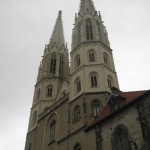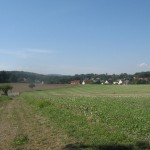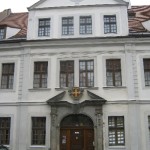
Observant readers of this blog may have noticed that my wife Sybille, has not had a mention in any of my recent posts. This is because on Maundy Thursday 2nd April, Sybille travelled by train from Prague to Görlitz, a town lying in the south-eastern corner of the former East Germany on the border with Poland. Then on Good Friday morning, she set out to walk from Görlitz, 470 km along Der Ökumenische Pilgerweg, to the small town of Vacha, which lies on the former Inner German Border.
Der Ökumenische Pilgerweg was established in 2002-3, almost solely by the efforts of one lady, Esther Zeiher. It follows the line of the ancient Via Regia passing through Leipzig, Erfurt and Eisenach. Simple pilgrim accommodation is available along the way at quite reasonable cost, provided by both the Roman Catholic and Protestant Churches.
Sybille’s original plan was to complete her pilgrimage and be back in Prague, before I left for the ICS Chaplains Conference in the Netherlands on Monday 27th April. But a slight problem with her knee just over two weeks into her journey, caused a delay in her anticipated schedule. Fortunately, ‘Aunty Karen’ agreed to have Šárek the cat whilst I was to be away, allowing Sybille to complete her pilgrimage, which she did by successfully, arriving in Vacha on Wednesday 29th April. She was then able to stay on in Vacha for another night, allowing me to pick her up on my return journey to Prague from the Netherlands, on Friday 1st May.
So after breakfast on Friday 1st May, I set off from the Mennorode Conference Centre, driving back into Germany and soon afterwards headed south towards Dortmund and then east towards Kassel, the city where Sybille was born. Then it was south again and around Bad Hersfeld, before leaving the autobahn for the final 20 km into Vacha. I had promised Sybille that I would reach her between 14.00 and 14.30, so I was pleased to drive into the town square of Vacha at 14.15, to be greeted by Sybille, seeking to attract my attention by waving my walking pole at me!
Vacha, pronounced by the locals ‘Facher‘ – native English-speakers beware 🙂 – lies within the former East Germany, adjacent to the Inner German Border with the former West Germany. These days, the Inner German Border is simply the boundary between the Bundesland of Thüringen and the Bundesland of Hessen. But there remains on the edge of the town, both evidence of recent past history, together with artwork celebrating the end, in November 1989, of the post-Second World War internal division of Germany.

The remains of the dividing wall between East and West.




Decoration of an electricity sub station, adjacent to the dividing wall.

Overlooking both the sub station and the dividing wall, was this watchtower, surrounded by scaffolding as it is undergoing restoration! I forgot to photograph it but fortunately, Sybille did!. But it does raise the question that I’ve written about previously on this blog, as to what structures and memorials from past unpleasant history do you preserve, and what do you demolish or destroy?
Deciding that I was too tired to drive all the way back to Prague that day, we headed eastwards and eventually turned off the autobahn to the town of Apolda where we stayed in a B and B overnight. In the centre of Apolda was a large red brick Protestant Church with an early reminder of the forthcoming five-hundredth anniversary of Martin Luther and the German Reformation to be marked and celebrated in two years time.





Sounds amazing, and makes me very excited to learn more about pilgrimages from Sybille 🙂
The Ökumenische Pilgerweg sounds fascinating to me too, Tash. I would loved to have walked the whole way with Sybille.
Really enjoyed reading about this as a German history nut… I’ve never been to an East/West German border area besides Berlin. Also, the walking pilgrimages Sybille does are also so interesting to me- I’m sure she encounters many new things and people along her way.
Glad you enjoyed it, Cynthia. I’ve visited numerous parts of the former West Germany, both before & after the fall of the Iron Curtain. And since living in Prague, I’ve visited Dresden & driven across the former East Germany to get to Berlin. But until this recent trip to the Netherlands, I had never driven from East to West & return. Crossing the former Inner German Border is quite a fascinating experience, especially seeing what has or is being preserved for posterity, & what has been eradicated.
What you say about walking pilgrimages, is very true. You meet new people and see places at much closer quarters than when travelling by car or train.
What a fascinating route for a pilgrimage way, Ricky. I’m glad Sybille was able to complete it despite her knee problem. My only glimpse of the Grenze was in the early 1960s (63 or 64) when I was staying with my German penfriend in Hamburg. Her parents took us on a trip to see the border close to where it reached the Baltic and I’ve never forgotten the sight and the way it brought home the reality of a country divided in this way, It made a big impression on the rather young 17 or 18 year-old I then was.
It is a fascinating route passing through places having strong associations with Luther as well as ones with Roman Catholic connections. My only regret was not being able to walk it with her – some of us have work 🙁
As I said in my earlier reply to Cynthia, although I’ve spent time in both the former West Germany & former East Germany, this was the first time I’d ever driven from East to West & back again. It was fascinating at Vacha, to read about and to see where the Grenze once was, and to see what has & is being preserved as a reminder of how things were post WW2 until 1989.
Hi Ricky,
I have to say I think the artwork on the sub-station is an excellent method of commemoration in this instance. It records the facts, spells out the changes that have taken place and depicts the hopes for the future; without being offensive or triumphalist toward any section of the newly ‘one’ people. Would that we in Ireland were so successful in our commemorations of our shared yet divisive history. Thought provoking article Ricky, thank you.
Hi Sean,
I agree with you entirely about the artwork. No triumphalism whatsoever. The only thing I find slightly strange is renovating & restoring the watchtower.